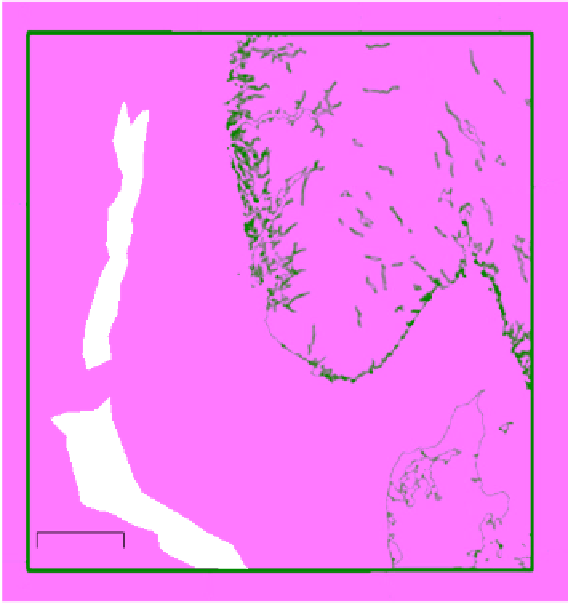Geoscience Reference
In-Depth Information
N
SF
HP
60
°
HF
ØFC
ESP
VG
SB
g. 6c
LD
PBR
ÅG
UH
MFB
SP
EB
FFZ
LFB
STZ
NDB
CG
100 km
56
°
RFH
0
°
4
°
8
°
Fig. 3.
Main structural elements in the study area (main Permian and Late Jurassic rift basins marked in yellow and blue
respectively): Central Graben (CG), Coffee-Soil Fault Complex (CSFC), Egersund Basin (EB), East Shetland Platform (ESP),
Fjerrislev Fault Zone (FFZ), Hardangerfjord (HF), Horda Platform (HP), Ling Depression (LD), Lista Fault Blocks (LFB),
Moray Firth Basin (MFB), Norwegian Danish Basin (NDB), Patchbank Ridge (PBR), Ringkøbing Fyn High (RFH), Stord
Basin (SB), Sognefjord (SF), Stavanger Platform (SP), Sorgenfrei Torquist Zone (STZ), Utsira High (UH), Viking Graben
(VG), Øygarden Fault Complex (ØFC) and Åsta Grabe (ÅG).
Gabrielsen
et al
., 1990; Heeremans & Faleide,
2004). The active stretching stage of this rift event
is considered to have ceased in earliest Triassic
times. However, the post-rift subsidence stretched
well into the Late Triassic (Gabrielsen
et al
., 1990;
Odinsen
et al
., 2000).
The Late Jurassic to earliest Cretaceous rift
phase mainly affected the (present) continental
shelf, including the northern, central and eastern
North Sea (Badley
et al
., 1988; Ziegler & van
Hoorn, 1989; Gabrielsen
et al
., 1990; Roberts
et al
.,
1990; Ziegler, 1990, 1992; Yielding & Roberts,
1992; Milton, 1993; Rattey & Hayward, 1993;
Steel, 1993; Nøttvedt
et al
., 1995; Færseth, 1996;
Færseth
et al
., 1997; Odinsen
et al
., 2000; Faleide
et al
., 2002). During the Late Jurassic to earliest
Cretaceous syn-rift phase, NW to SE trending
structures like the Central Graben dominated the
central North Sea, whereas structures with NNE to
SSW orientation were dominant in the northern
North Sea (e.g. Viking Graben: Ziegler, 1987;
Ziegler & Van Hoorn, 1989; Fig. 3). During the syn-
rift stage, extensive hinterland areas, like the
south Norwegian mainland and the East Shetland
Platform, sourced the basin. However, several
more local source areas, like the uplifted margins
of the basins and emergent crests of rotated fault
blocks, supplied sediments to the basin system as
well (e.g. Gabrielsen
et al
., 2001, 2010a).
During the Late Cretaceous to Early Palaeocene,
the Chalk Group, representing dominantly shallow
marine depositional environments, accumulated
in the Egersund Basin and Åsta Graben areas to a
thickness of up to 900 metres and in the Central
Graben area up to 1500 metres (Surlyk
et al
., 2003).
It should be emphasised that chalk sediments have
later been completely eroded in areas east and
north-east of the Norwegian Channel during the
Cenozoic.
During the Late Palaeocene to Eocene, break-up
of the NE Atlantic influenced the northern North
Sea by the uplift and eastward tilting of the East










































































































































































































































































































































































































































































































































Search WWH ::

Custom Search